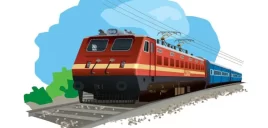Axle counters are widely used by IR to ensure that all wagons or coaches of a train have indeed passed a given point — out of a block section, out of the station limits, out of yard limits, other point zones, etc. (‘last vehicle proving’, ‘block proving’, or ‘block verification’, serving the same purpose as the visual ‘Last Vehicle Check’ or LVC that is done otherwise). Axle counters may be of the single or multiple entry type. Axle counters today are mostly of the electronic variety. They use piezoelectric sensors on the tracks, which are triggered by the weight of a pair of wheels moving over them. Older models with electromechanical treadles actuated by the wheels of a passing train are also seen, as are some variants which use photoelectric detectors or magnetic detectors (using the Hall effect to sense the perturbation of magnetic flux) to count axles. The ‘counting’ is today usually done by digital circuits (‘SSDAC’ = solid-state digital axle counter, also generically termed an ‘electronic axle counter’), but in the past the counting up and down was accomplished using electromechanical relay circuits. Digital circuits are more compact and far more reliable than the older electromechanical counters.
Usually two sensors are installed, at either end of the track section to be monitored – one that counts up as axles enter the section, and the other which counts down as axles leave the section. The section is deemed to be clear only when the resultant count is zero. More complex installations with additional sensors are sometimes used, where the counts of axles registered by each sensor are compared with logic taking into account the direction of motion, etc., to yield a final result of whether the section is clear or occupied. Signals and points are interlocked with the occupancy indication from the axle counter so as to prevent trains from being routed to occupied sections.
As with much other trackside equipment, the sensors are usually powered by a 24V DC supply; there may be battery back-ups for reliability. In the case of solid-state equipment, there are even redundant computation paths provided so that the final decision of track occupancy is done with a ‘2 out of 2’ or ‘best of 3’ choice from multiple logic units.
A typical axle counter is usually able to handle track sections up to a few kilometers in length, and all typical train speeds seen today in India. Maximum counts registered by sensors may be quite high, as much as 16,000 (not for long trains (!), but to keep track of total traffic in a given period).
Even with all this the axle counts are not 100% accurate and there are sometimes glitches in the counts. One sometimes sees small rooms marked ‘Axle Counter Room’ near the station master’s office where the equipment for reading the axle counts is housed. One of the supplies of digital axle counters in India is Applied Electro-Magnetics India, Ltd. The use of axle counters was pioneered by WR and CR. Over 65,000 are now used across India
Source – IFRCA.org
Disclaimer: The Information /News /Video provided in this Platform has been collected from different sources. We Believe that “Knowledge Is Power” and our aim is to create general awareness among people and make them powerful through easily accessible Information. NOTE: We do not take any responsibility of authenticity of Information/News/Videos.
This entry was posted in 2 Railway Employee, STUDY NEW, Railway Employee











